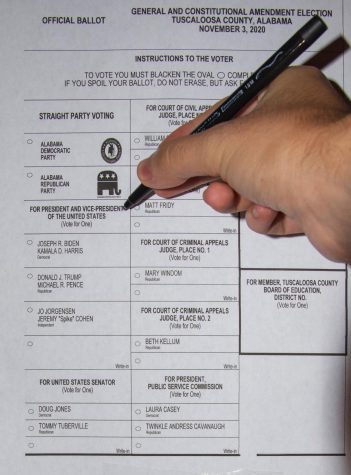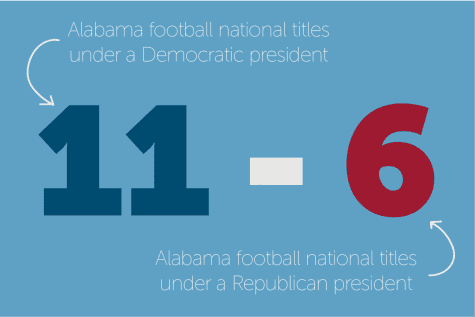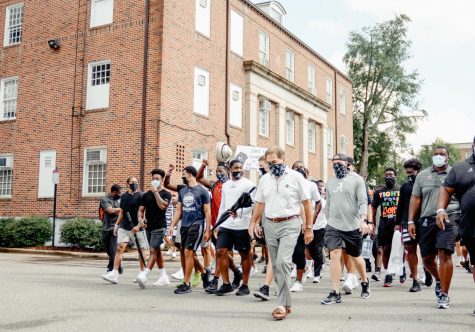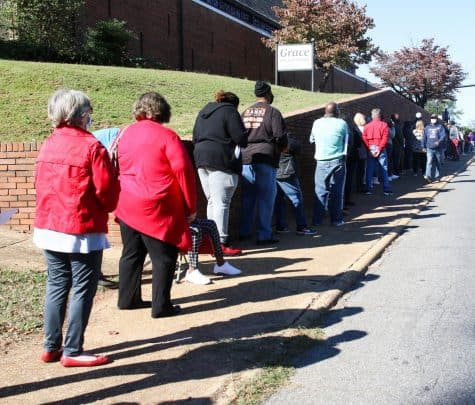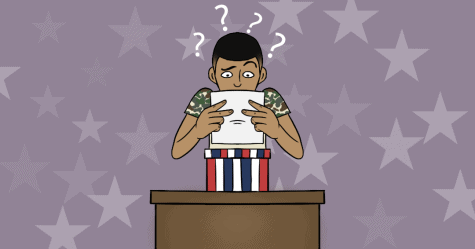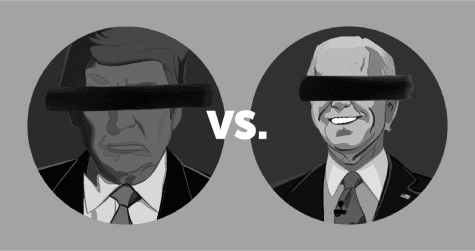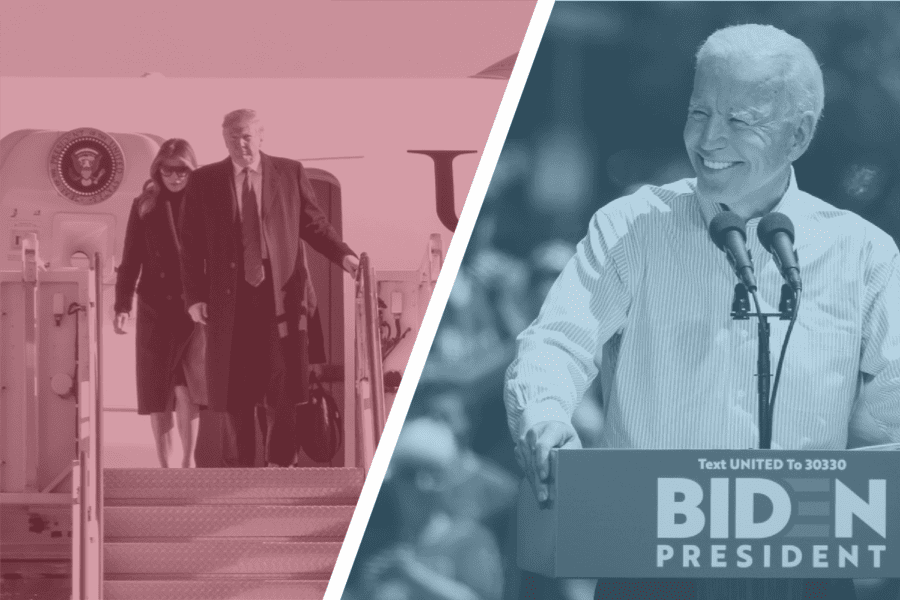Presidential Platforms: How Trump and Biden’s plans and policies stack up
Here’s one last synopsis before you put a pen to your ballot on Tuesday.
Read more from the Nov. 2 Election Edition.
From beating COVID-19 to addressing climate change, President Donald Trump and former Vice President Joe Biden have vastly different plans for the country.
Political science professor Allen Linken noted that this is the first time in many years that voters are substantially considering a candidate’s age as a factor.
“Beyond that, there is something to be said that both candidates are two generations removed from [students] and [their] peers, which creates a divide that has rarely happened,” Linken said.
He also noted that students are voting during a crisis that has “not only changed the course of the national economy,” but it’s affected voters through issues like mask orders, altering of campaigning, expansion of mail-in ballots and early voting options.
UA College Democrats President Justin Levy said Biden’s platform focuses on civil rights, diversity, “battling COVID-19 with science and logic,” and building the economy.
Levy also noted the type of leadership Biden has the potential to bring to the White House.
“I think I can sum it up in three words: empathy, truth and diversity,” Levy said. “He is going to lead with all three of those things. He listens to the needs and wants of the American people… that’s what we need in a politician.”
A representative for the UA College Republicans could not be reached for comment, but Students for Trump member Zoie Bryant said Trump’s platform is one that focuses on “continuing to build the American economy, maintaining freedoms and keeping America great.”
Bryant also shared her take on Trump’s leadership.
“He will continue to lead with good work ethic, honesty and love for the American people and our country,” said Bryant.
Learn more about both candidates and their plans and policies below.
Pandemic Response
President Trump has signed several laws during the COVID-19 crisis that distributed funding to families, businesses, and agencies. The largest of these laws, The Coronavirus Aid, Relief and Economic Security Act, sometimes called the CARES Act, provided over $2 trillion in government funding to American families and businesses in trouble. The Paycheck Protection Program and Health Care Enhancement Act also provided over $483.4 billion for hospitals, COVID-19 testing, and small businesses. But, according to aggregated polling from FiveThirtyEight, most Americans do not approve of Trump’s handling of the pandemic, and a majority of voters also would have preferred prioritizing additional COVID-19 relief packages over the confirmation of Amy Coney Barrett, Trump’s recent nomination to the Supreme Court.
Democratic opponent Biden is looking to return leadership on COVID-19 back to the federal government by providing clear and concise instructions to schools, businesses and everyday Americans on how to safely combat the virus. He has criticized the Trump administration’s handling of the COVID-19 outbreak, and if elected, vows to listen to the science in order to contain it. Biden is looking to increase regular, free and reliable testing and is also interested in using the Defense Production Act to produce more PPE. The Biden platform also promises effective and equal distribution of a vaccine by investing over $25 billion in a manufacturing and distribution system.
Civil Rights
In the wake of national protests against police brutality, Trump said that he has worked tirelessly throughout his presidency to promote and support minority groups. He cited the economy pre-pandemic, which saw some of the lowest rates of unemployment for Black and Latinx people. In 2019 he signed a reform bill which changed federal prison sentencing laws that disproportionately affected Black Americans. This past June the president signed an executive order encouraging police departments to change how they train their officers and use force against citizens. Still, Trump and his administration continue to face claims that he is racist, given his “many sides” comments after the 2017 Unite the Right Rally in Charlottesville, immigration policies and recent hesitance to condemn white supremacy at the first presidential debate.
Biden believes that racism is a prominent issue within the country and that it needs urgent attention. He acknowledges the divides between white and Black communities, as well as between other minority groups. However, Biden has been largely criticized for previously having supported the Violent Crime Control and Law Enforcement Act, also called the 1994 Crime Bill, which instilled long prison sentences even for people convicted of low-level crime. The laws have disproportionately affected Black Americans. If he obtains the presidency, he claims he is committed to removing racism from the criminal justice system and will begin by enacting policies to close the racial wealth gap.
Climate Change
The Trump administration has been criticized for not taking the threat of climate change seriously. At the beginning of his presidency, the U.S. withdrew from the Paris Agreement, an international pact to limit global carbon emissions. The formal withdrawal will occur on Wednesday, just one day after the election. Since taking office in 2016, Trump has repealed more than 100 environmental regulations.
Biden plans to recommit to the Paris Agreement and to combating climate change. He is a supporter of the Green New Deal, a plan designed to fight climate change and greenhouse gases. Biden is also looking to reinstate Obama-era environmental regulations. His “Clean Energy Revolutions” plan would invest $1.7 trillion into the environment to help control consumption and extraction of fossil fuels and research clean energy alternatives.
Education
Trump’s focus on education the last four years has included providing more federal funds to private and charter schools. School choice has been a large piece of Trump’s education policies, though critics say that such policies divert money away from the public schools that need it. Trump has additionally signed the FUTURE Act, which authorizes over $255 million in annual funding for minority-serving colleges and universities.
Biden’s plans for education include increasing funding for colleges and universities that serve Black, Hispanic and Native American students. He also wants to provide free tuition at public universities to students whose families make less than $125,000 a year. Over $100 billion in low-interest loans would also be provided by strengthening Community Development Financial Institutions. The Community Reinvestment Act would also be reevaluated so minority neighborhoods aren’t impacted by redlining, a historically racist tactic used to bar loans from individuals in areas deemed to be low-income.
Jobs
As a result of the COVID-19 pandemic, the U.S. economy has suffered the loss of over 4.6 million jobs. Prior to the virus, Trump helped create over six million jobs for Americans, building on the 152.2 million individuals working at the end of Obama’s term. Trump had created a 4.3% increase within the job market, though that progress has been more than lost. Moving forward, Trump’s goals for a potential second term include creating 10 million jobs in 10 months, as well as creating one million new small businesses. However, Trump’s plan does seem to hinge on his goals surrounding the pandemic. The Trump campaign’s agenda for a second term includes developing a vaccine for COVID-19 by the end of 2020 and a “Return to Normal in 2021.”
Biden plans to create five million new jobs with his “Buy America” plan. The government would invest $400 billion to buy U.S. products and services and another $300 billion would fund research and development, mostly for clean energy research. The Biden campaign has said the plan will create 5 million jobs, all of which will be required to pay an hourly rate of at least $15 per hour under Biden’s raised minimum wage policy.
Taxes
Trump signed the Tax Cuts and Jobs Act in 2017, which cut the top individual tax rate from 39.6% to 37%. It also eliminated many itemized deductions until 2025. In addition, Trump cut the corporate tax rate from 35% to 21%.
Biden plans to make the tax code more progressive. This includes making high-income households pay a larger share of their incomes in taxes than lower-income taxpayers. He additionally wants to repeal the Trump tax cuts and raise the corporate tax rate back up to 28%. Biden also has plans to add a 12.4% social security payroll tax for individuals who make over $400,000. CBS News reports that the Biden plan is projected to raise more than $4 trillion over 10 years.
Anyone interested in learning more information on Trump, Biden or either party can reach out to the UA College Democrats or UA College Republicans.



